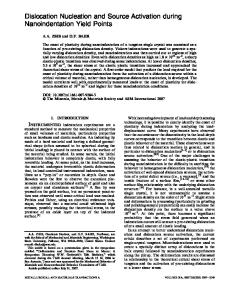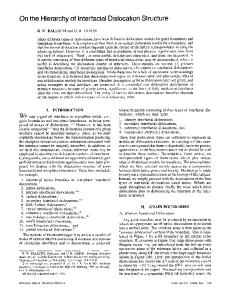Effect of Surface Steps on Dislocation Structure During Nanoindentation
- PDF / 1,539,836 Bytes
- 6 Pages / 612 x 792 pts (letter) Page_size
- 11 Downloads / 386 Views
EFFECT OF SURFACE STEPS ON DISLOCATION STRUCTURE DURING NANOINDENTATION JONATHAN A. ZIMMERMAN*, PATRICK A. KLEIN and STEPHEN M. FOILES Sandia National Laboratories, P.O. Box 969, Mail Stop 9161, Livermore, CA 94551 * contact author, e-mail: [email protected] ABSTRACT Nucleation of dislocations during nanoindentation is a prime example of how nanoscopic details play an important role in the evolution of macroscopic mechanical behavior. Experimental studies of nanoindentation show that surface irregularities, such as steps, alter the mechanical response during indentation. Atomistic simulations using the embedded atom method are used to examine the indentation of a Au(111) crystal with a surface step. The amount of force needed to nucleate dislocations decreases significantly for indentation close to the step. A recently formulated atomistic deformation metric, the slip vector, is used to quantify dislocation content. This metric is used with the local atomic stress to determine the critical resolved shear stress necessary for dislocation nucleation. Atomic stress fields are also compared with continuum calculations performed using non-linear elasticity with a constitutive relation based on the same interatomic potential. This constitutive model shows good agreement of indentation forces and stresses with the atomistic simulations. INTRODUCTION Nanoindentation of a crystal is a standard method used to determine critical energies and stresses needed for defect nucleation and propagation within materials. Indentation has been thoroughly studied both analytically [1] and experimentally [2, 3, 4]. Little of this work produced information about the initial formation of dislocation loops, which signifies the onset of plasticity. Experimental observations [5] have shown that surface steps play a role in the nucleation of dislocations. The load needed to nucleate dislocations decreased for indentation close to these steps. Dislocation nucleation from nanoindentation has also been examined in simulation. Tadmor et al. [6, 7] used the quasicontinuum method to study 2-dimensional nanoindentation from a rigid punch. While these simulations produced information about the contribution of image forces and surface energies to dislocation nucleation, the Burgers vectors of the dislocations were restricted by the geometry of the simulation region, which would alter any estimation of critical resolved shear stress. Kelchner, Plimpton and Hamilton [8] used a repulsive potential to model a spherical indenter penetrating the surface of a Au(111) crystal modeled with the embedded atom method (EAM) [9]. This work introduced the centrosymmetry parameter to analyze the complex dislocation loops formed within the crystal. We examine the indentation of a Au(111) crystal containing a surface step. Our simulations show that indenter-step contact explains the drop in indentation force when the indenter is close to the step. A new deformation metric, the slip vector, identifies the Burgers vector content of the nucleated loops. The slip vector is used
Data Loading...










